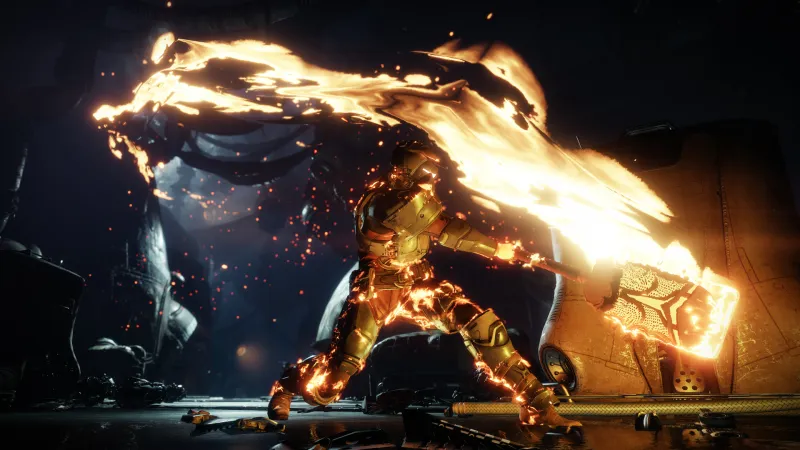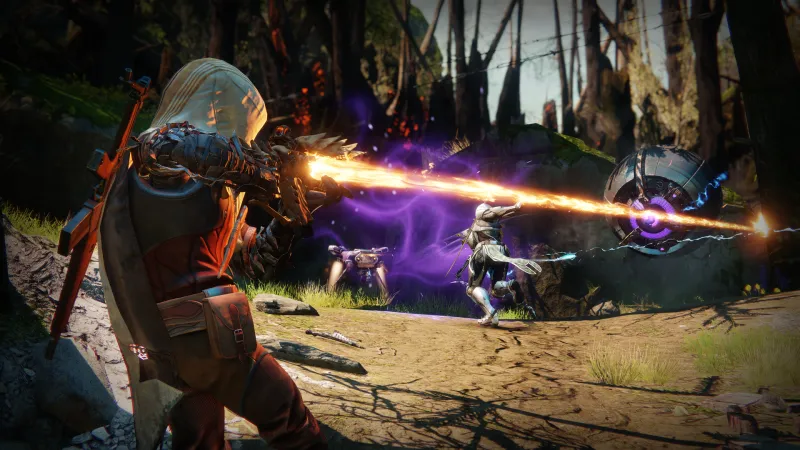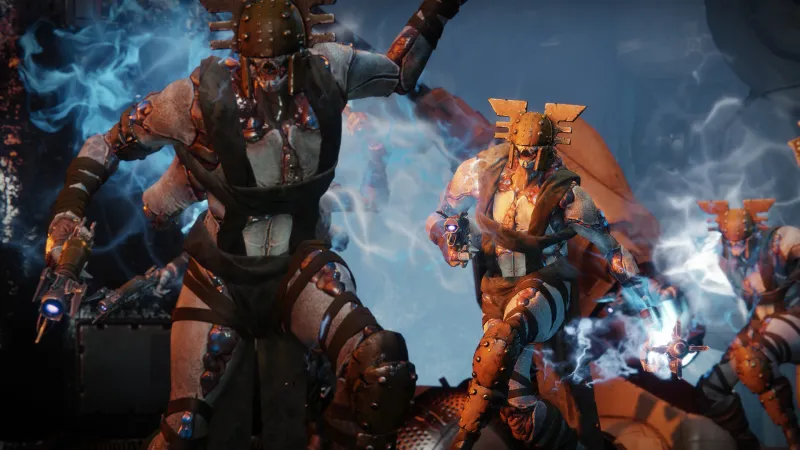


In partnership with High Moon Studios, Bungie launched Forsaken last week to tense anticipation. Without anyone from the developers saying so directly, it’s clear that this is a make-or-break moment for the game. Destiny 2 hit last fall to significant initial praise, but each subsequent month revealed a tail to the game that struggled to meet the demands of its hobbyist players. After some positive signs in recent months (including the generally well-received Warmind), Forsaken needed to come out swinging and revitalize a game and series for which enthusiasm from many players had flagged, an effort we detailed in our cover story and its related online hub. Forsaken has now arrived, not just with a ton of new game modes and content to enjoy, but also a fundamental reworking of many core systems. It’s a truly massive expansion, with an overwhelming breadth of experiences to explore.
Several of the most important elements, including a promised raid and features of an endgame zone that are meant to evolve over time, are yet to manifest in the natural flow of the unfolding game, so we're holding off on our final review. Even so, after several days of exploration and discovery, it’s clear that Forsaken is a rich and rewarding adventure, characterized by nuanced storytelling and worldbuilding, slow but steady character progression, broad choice in playstyle and activity variety, and mission design that is challenging, action-packed, and engrossing.
On its surface, Forsaken’s campaign is a story of revenge, as our player character fights through a cadre of hardened criminal aliens to avenge a murdered friend. More importantly, Forsaken’s campaign wrestles with issues of genuine pathos and consequence, including a central question about whether the reason someone is killed matters as much as the fact that they’re targeted for death. The storytelling tone is dark and somber, and it’s refreshing to see these nearly immortal heroes struggling with grief and loss; even the normal celebratory Tower is characterized by melancholy in music and character interactions.
Several excellent story missions and adventures relay the core story of bringing down the barons and their boss, the delightfully sneering Uldren Sov. Each boss has personality that is expressed not just through dialogue and visuals, but also through the missions where we confront them, from the wily traps of the Trickster to the macabre overtones of the Mindbender. The Tangled Shore destination expertly adds layers to the experience, communicating the sense of a chaotic and untamed Old West, where our characters are literally on the edge of the void.

Beyond the campaign waits the Dreaming City, the Destiny series’ first true endgame zone. Breathtaking architecture, misty landscapes, and dreamy skyboxes begin to unveil the secrets of the enigmatic Awoken race. Clearly modeled on the success of the Dreadnaught in The Taken King, this new destination is awash in secret platforms and chests, hidden discoverable items, and in one place, Destiny’s best public event to-date – a tower-defense inspired throwdown that makes for a great skirmish. The Dreaming City also plays host to a new endgame wave-based enemy encounter called the Blind Well. The battles here are frantic as you move between different bubbles of safety while taking out hordes of charging foes, but I’m eager to see if subsequent weeks and challenge levels offer more variety. And, like so many of these types of activities in previous Destiny releases, I’m confounded by the absence of meaningful matchmaking.
As a whole, the Dreaming City is a thrilling new locale, and I love the idea of dedicated aspirational destination for endgame players. While I enjoy the freeform nature of the Dreaming City, there are times that I wish the area had a few more structured activities or ideas, both to communicate the narrative of the place and encourage player understanding of the interlocking collectibles and activities available. There’s much yet to learn about the breadth of the experience here, as the developers have promised a destination that evolves over time.
Forsaken also introduces a brand-new core game type. Rather than cribbing directly from other popular game types like Horde or Battle Royale, Gambit is a refreshingly new mix of cooperative enemy combat, strategic resource banking, and momentary bursts of competitive tension. The mode is gripping and accessible, with smart UI that communicates what you need to know, and dynamic dialogue that further helps you keep track of what’s happening. The experience is immediately playable and fun. At the same time, multiple strategies are viable, and with each passing day, I see new layers to the mode, which is a testament to its sophistication. I’m particularly impressed by the dynamic balancing at work here, which keeps a match competitive to the very end, even as one team seems to pull ahead. I’ve encountered more than a couple of times in which total blowouts got turned around, and a team won a clutch victory. I regularly find my heartrate accelerating in the final moments of a round. Gambit begs for additional twists and variations, and I’m confident Bungie has those in store for the future.

With the release of Forsaken, new Crucible maps and modes have been decoupled from the regular expansion schedule. As such, there’s not a lot to talk about with the competitive game, especially since the top-tier Trials of the Nine experience has been benched for the time being to be reworked. Nonetheless, changes to the weapon systems and balance are on full display in the Crucible. Games move faster, Guardians are far more lethal, and individual team members can turn the tide of a fight with some big plays. Not everyone will love the return of so many one-shot kill options, but the combat is certainly fiercer and more intense than it was just a few months ago. For my part, as a middle-of-the-road skill PvP player, I’ve found a lot to like in these brutal new contests, especially when I play defensively and make smart weapon choices for the map I’m on.
Forsaken also ushers in some dramatic reworking of many of its core systems, including a drastic overhaul of economy and resources, a new approach to weapon slots, and a fundamental reimagining of progression, gear perks, mods, infusion, and day-to-day milestones. While it would be easy to get lost in the nitty-gritty details of each of these, they combine to create a flow to the game that feels fresh and filled with variety. The best thing that can be said about the new weapon slot system is how little you notice it; while moving powerful weapons like shotguns and fusion rifles back into more regular usage, the system remains balanced and smart on multiple levels of play. Meanwhile, progression feels slow but smooth, offering dozens of ways to improve your character in any given week, with the cumulative effect being that you can choose what you want to do with your in-game time, rather than feeling shoehorned into activities you don’t enjoy. At any given time, I’m juggling a mix of bounties, challenges, exotic quests, and milestones; accomplishing multiple goals across one activity is deeply satisfying.
So far, I’m not a big fan of the new mod and infusion systems, but some minor reworking could do wonders to improve my opinion. I like that that the new mods are powerful and encourage distinct playstyles, but they’re too rare and hard to acquire up to this point to allow for meaningful experimentation. Bungie seems to feel similarly, as mods are supposedly already being hotfixed this week to drop more regularly, so I'm eager to see how that works out. Similarly, the new infusion system reintegrates planetary materials (like in Destiny 1), which offers a good reason to return to old destinations, which is a welcome effort. But the exceedingly high costs of infusion also discourage experimenting with new gear builds in the endgame. With both mods and infusion, slightly less punishing loops would let players shape their playstyle in fun ways, leading to a variety of awesome setups that capitalize on the breadth of new perks.

Wrapped around the entirety of the Destiny 2 experience, Forsaken also introduces a new Triumph system and gear collection system. Hand-in-hand, these two systems are exactly what the game needed to maintain hobby-style play. Triumphs offer discrete tasks to chase, and tease secrets that you might not yet have uncovered, and in the long term, there are even opportunities to chase specific titles related to what you focus on. Not to be overlooked, the Triumph system also introduces a new in-game tab for collecting and reading lore – for some players, these surprisingly complex storylines will finally help sell the depth of the Destiny fiction. Just for completion’s sake, I still wish that Bungie would add a few more sub-tabs that include all the old lore from Destiny 1 to peruse in down times, and to encourage a more complete understanding of the world by its players.
Collections accomplish a similar goal to Triumphs, but with the items you’ve gathered. Like a trophy wall representing your treasure acquired across the beleaguered solar system, it’s also a way to keep track of what you still have to chase. Plus, with the addition of these collections, many items are retrievable for a small fee, helping to ease the fear that collectors (like me) have about deleting old items. Sadly, with the addition of random rolls on new legendary weapons and armor, the Collections tab feels like it is missing an essential component. I hope Bungie can continue to brainstorm and find a way to let players reacquire gear pieces with random rolls from the Collections. If players could “lock” a particular configuration of perks for a given gun or armor piece, and always retrieve that version until they chose to lock in a different version, I’d be very happy. Alternately, even if the developers chose a single static roll for any given item, that would be better than nothing. No matter the solution, it’s currently a bummer that the bulk of the new items in Forsaken don’t feature this important functionality. Of course, I’m not the one responsible for figuring out how that would work in the game’s back end, so it’s easy for me to say.
Taken together, Triumphs and Collections are a fixture of the game that feels overdue, but also welcome now that they’re here (hopefully to stay). I love that both systems are planned to update over time, so each new content piece can bring new tasks and items to chase.

As discussed above, Destiny 2: Forsaken has several beats of its core experience yet to unfold, and we’re choosing to hold our final evaluation for a few days more in order to test some of these out. If you choose to return and check out that eventual review, I’m confident that you’ll see at least some of my thoughts from above reflected or repeated in the final assessment. With that said, Bungie and High Moon Studios have crafted an immense adventure that is meant to be experienced over time, and in respect to that welcome dynamic structure, I need to see a bit more of that before declaring a final score.
But even if the full picture hasn’t yet come into focus, the time I’ve spent in-game so far suggests that this is a phenomenal release, and easily sits beside the best that Destiny has offered to date. For players who have stayed for all the ups and downs that the series has gone through, the dark tone and complex systems at play here are immersive and intriguing. Lapsed players would do well to consider a return trip to uncover the secrets of the Reef; this is as good as Destiny has felt since The Taken King. That only leaves new players, which Forsaken might not be targeting here. The complicated systems will be tricky to parse for newcomers, and the weight of the story demands that you know and care about the universe that has been set up prior to now. Without following along with the community, many of the systems and secrets are likely to remain opaque to the casual player.
In this case, that’s a design decision I can accept; a given game can’t be all things to all people, and it feels like Destiny 2 needs to take some time to cater to its most devoted fans. Destiny 2’s base game did a lot to remain accessible and newcomer-friendly. Forsaken goes the other direction; the long but satisfying grind, engaging competitive and cooperative offerings, and the wealth of secrets beg for deeper engagement; for those who are eager for just that, and willing to put in the time, this expansion is ready to pull you all the way back in.

Explore your favorite games in premium print format, delivered to your door.